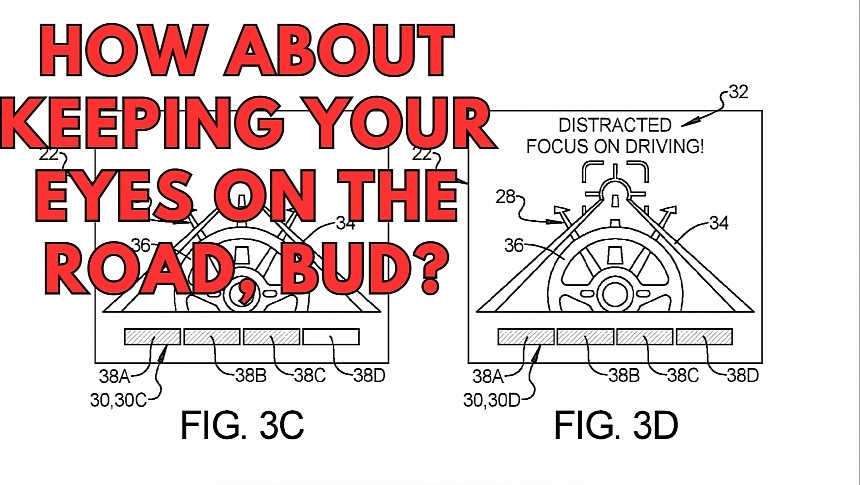Driver monitoring systems have existed for some time, but General Motors believes all current implementations lack one crucial aspect.
They don't come with a preventive approach, as they rely on a binary basis, either telling drivers they're not paying sufficient attention to the road or issuing no notification (in which case, it assumes the driver keeps their eyes on the road).
A new patent covering a driver state display proposes a friendlier approach.
General Motors believes that a driver monitoring system can and should boast multiple states, helping the drivers avoid reaching a certain distraction threshold and generating an alert.
The American carmaker says the technology can use the hardware already available on cars and powering driver monitoring systems. Its driver state display would come as an upgrade, featuring multiple indicators to indicate the current state.
The easiest way to understand how GM's new system would work is to think of a threshold when the driver monitoring system would generate an alert. If the system generates an alert when you've been looking at the infotainment system for three seconds, GM's new feature could display an alert one second before. The same behavior can be used for any other distraction type, as the technology can prevent alerts by giving drivers enough time to bring their eyes back to the road.
The friendlier approach makes perfect sense, fixing a problem no other carmaker probably considered when fitting driver monitoring systems on their models.
General Motors's solution doesn't generate extra costs either. As I said, the system will use the existing hardware (cameras and sensors installed in the cabin), so the carmaker must only update the software side of the technology to generate pre-alert notifications. A more advanced implementation with multiple indicators and a display can generate additional costs according to the version picked by the carmaker.
In one implementation, General Motors envisions a display that permanently keeps a so-called normal driver status indicator active. Furthermore, the system can communicate with automatic braking systems, allowing the car to engage the brakes preventively if it detects a risk of crash and the driver doesn't look at the road.
The system can eventually receive updates with more advanced capabilities, such as generating statistics when arriving at the destination. The driver can analyze the overall level of distraction during the journey – the data could also come in handy in company cars where fleet operators might want to analyze driver behavior behind the wheel.
For now, GM's system is just a patent, and I highly doubt the company will ever bring this idea to the mass production stage. The concept can undoubtedly help boost safety behind the wheel. Still, it doesn't make sense from a cost perspective, especially if the carmaker wants to install more advanced hardware for trip analysis. The current driver monitoring systems serve their purpose correctly, so perhaps GM wanted to protect its idea if it takes off in the future.
A new patent covering a driver state display proposes a friendlier approach.
General Motors believes that a driver monitoring system can and should boast multiple states, helping the drivers avoid reaching a certain distraction threshold and generating an alert.
The American carmaker says the technology can use the hardware already available on cars and powering driver monitoring systems. Its driver state display would come as an upgrade, featuring multiple indicators to indicate the current state.
The easiest way to understand how GM's new system would work is to think of a threshold when the driver monitoring system would generate an alert. If the system generates an alert when you've been looking at the infotainment system for three seconds, GM's new feature could display an alert one second before. The same behavior can be used for any other distraction type, as the technology can prevent alerts by giving drivers enough time to bring their eyes back to the road.
The friendlier approach makes perfect sense, fixing a problem no other carmaker probably considered when fitting driver monitoring systems on their models.
General Motors's solution doesn't generate extra costs either. As I said, the system will use the existing hardware (cameras and sensors installed in the cabin), so the carmaker must only update the software side of the technology to generate pre-alert notifications. A more advanced implementation with multiple indicators and a display can generate additional costs according to the version picked by the carmaker.
In one implementation, General Motors envisions a display that permanently keeps a so-called normal driver status indicator active. Furthermore, the system can communicate with automatic braking systems, allowing the car to engage the brakes preventively if it detects a risk of crash and the driver doesn't look at the road.
The system can eventually receive updates with more advanced capabilities, such as generating statistics when arriving at the destination. The driver can analyze the overall level of distraction during the journey – the data could also come in handy in company cars where fleet operators might want to analyze driver behavior behind the wheel.
For now, GM's system is just a patent, and I highly doubt the company will ever bring this idea to the mass production stage. The concept can undoubtedly help boost safety behind the wheel. Still, it doesn't make sense from a cost perspective, especially if the carmaker wants to install more advanced hardware for trip analysis. The current driver monitoring systems serve their purpose correctly, so perhaps GM wanted to protect its idea if it takes off in the future.















